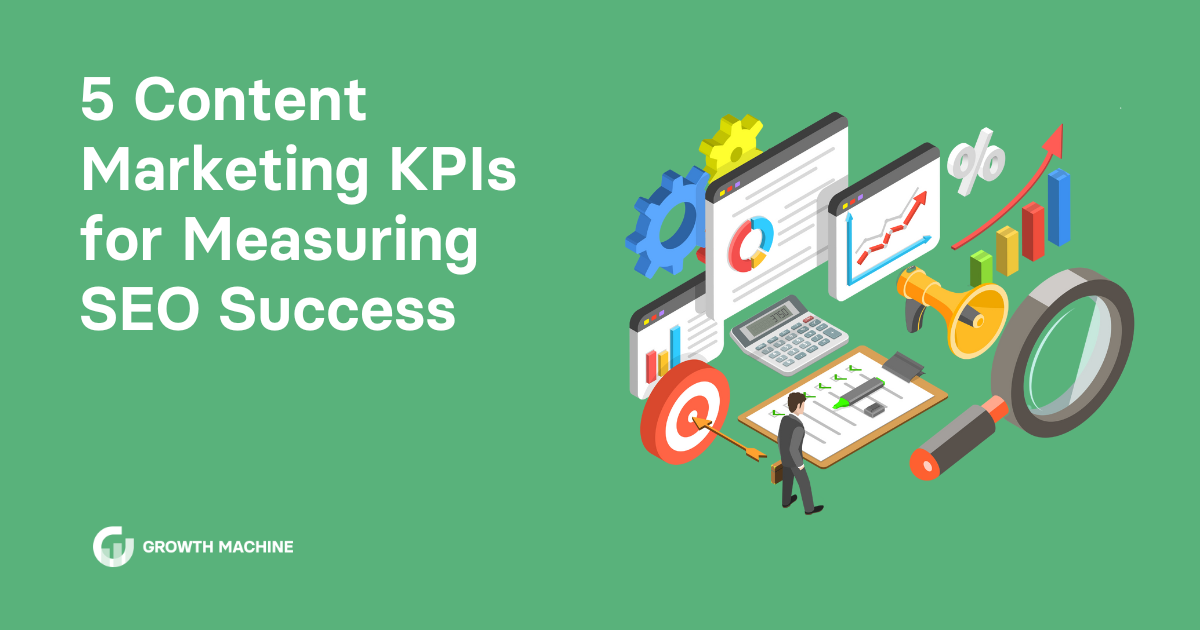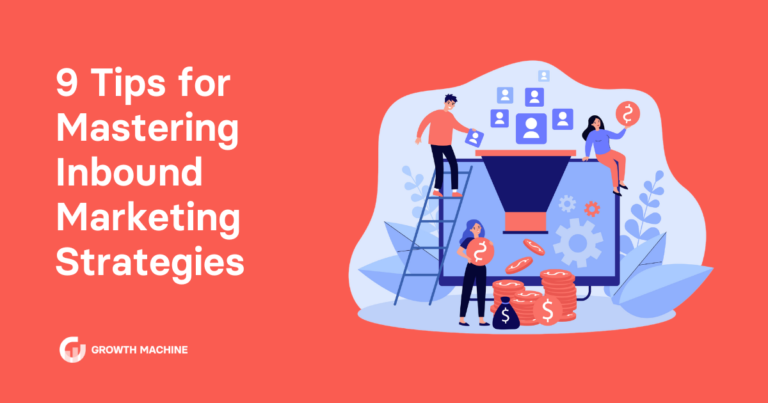5 Content Marketing KPIs for Measuring SEO Success
One of the biggest challenges in content marketing is understanding how well your strategy is performing, especially if you’re not yet a seasoned veteran.
The whole point of content marketing may be to improve your rankings and drive more organic traffic to your site, but keep in mind that SEO is a long game. It can take anywhere from three to six months for search engines to serve your content and for new pieces of content to show up in the search engine results pages (SERPs).
That’s where key performance indicators (KPIs) come in. Armed with the right KPIs, you can gauge your content’s effectiveness and make data-driven decisions.
We’ll walk you through the most important content marketing KPIs, explain how to track these metrics using analytics tools, and help you get insight into when to make strategic shifts in your content strategy.
So What Are Content Marketing KPIs?
Content marketing key performance indicators are metrics that tell the story of your content’s performance and its overall business impact. Think of them as your content’s vital signs — they help you understand if your strategy is healthy and delivering results.
These metrics span the entire content marketing lifecycle, from content creation to distribution to performance. Whether you’re creating blog posts, videos, infographics, or social media content, KPIs help you:
Understand the Value and Relevance of Your Content
Your content marketing KPIs reveal how well your content resonates with your target audience. Through metrics like engagement rates, time on page, and bounce rates, you can determine whether your content meets user needs and search intent.
For instance, if readers spend an average of five minutes on your how-to guides but only 30 seconds on your listicles, this indicates where you should focus your content creation efforts.
Track Format Performance
Different content formats serve different purposes, depending on your content marketing goals. By measuring performance across formats — from blog posts and white papers to videos and infographics — you can identify which types of content drive the best results for specific goals.
For example, a B2B company might discover that detailed case studies drive more qualified leads than general blog posts, while an e-commerce site might find that product comparison guides generate higher conversion rates than other formats.
Optimize Channel Strategy
Content marketing KPIs help you understand which distribution channels work best for your content. By tracking metrics across various platforms — whether that’s organic search, social media, email, or other channels — you can better allocate your resources and budget.
As an example, more than 90% of businesses in the U.S. are currently spending money on social media to promote their brand. So if you’re stuck on which channel to invest in, you stand to lose (possibly significant) funds.
On the other hand, if the data shows that creating quality content on LinkedIn drives more B2B leads for your company than short and snappy posts on X, formerly known as Twitter, then you can adjust your content distribution strategy accordingly.
Make Strategic Decisions
Content marketing KPIs inform your overall content strategy. They help you answer critical questions like:
- What topics should we cover next?
- Which content formats deserve more investment?
- When should we update existing content?
- How can we improve our content creation process?
- Where should we focus our content marketing budget?
Key performance indicators allow you to track your content creation efforts and the various formats you utilize so you can make data-driven decisions that improve your content marketing return on investment (ROI) and help achieve your business objectives.
5 Key Content Marketing Metrics to Measure the Success of Your SEO Efforts
Let’s explore the five main categories of content marketing KPIs and how successful businesses use them to measure and improve their content marketing performance.
1. Impressions/Search Visibility
Search impressions are the foundation of content marketing success. An impression occurs each time your content appears in search results, making it a vital early indicator of your content reach and visibility.
After all, if your content isn’t being shown to your target audience, you’re going to have a tough time building brand awareness.
For example, when one of our B2B software clients turned to us to help increase their website traffic, conversions, and brand recognition in the competitive tech space, we tracked key SEO KPIs like search impressions.
In less than two months, their new content began generating hundreds of daily impressions for their targeted keywords, proving that Google was recognizing and validating their content quality. While these impressions hadn’t yet translated to significant traffic, the steady increase in search visibility was an important early signal that our content strategy was working — the crucial first step toward earning more organic traffic.
When tracking impressions, pay attention to:
- Total daily and monthly impressions
- Impression growth trends
- Which content topics generate the most impressions
- Average position when impressions occur
- Types of search queries triggering impressions
2. User Engagement and Click-Through Rate
Once your content starts to gain more visibility in the search results, the next metric you want to turn your attention to is user engagement. In other words, how many people are actually clicking on your search listings?
The click-through rate (CTR) measures this directly by calculating the percentage of users who click on your content after seeing it in search results. A high CTR tells search engines that a webpage is relevant and offers valuable content to searchers.
We typically start seeing meaningful CTR data by month three or four of a content marketing campaign. Here’s what different CTR ranges typically indicate:
- 1%-2%: Below average, signals a potential mismatch between content and search intent
- 2%-4%: Average performance, room for optimization
- 4%-6%: Strong performance, especially for nonbranded terms
- 7%+: Exceptional, often seen with high-intent or branded searches
Improving your CTR often comes down to optimization of the following two key elements:
Title Tags
- Include your target keywords naturally
- Use numbers or data when relevant
- Create urgency or curiosity
- Lead with the most important information
Meta Descriptions
- Write compelling copy that expands on the title
- Include a clear call-to-action (CTA)
- Incorporate relevant keywords naturally
- Highlight unique value propositions
3. Search Engine Rankings
When it comes to search engine results, you want to focus less on the specific ranking position and more on ranking movement.
To get specific, we aim to see new content first appearing within the top 100 rankings, then gradually climbing higher. This progression indicates that your content is gaining traction.
To get a clear picture of the effectiveness of your content marketing strategy, monitor your rankings week over week. If you’re crafting relevant content that offers value to potential customers, you should start to see movement toward Google’s first page.
If you’re still not seeing ranking progress three to four months into publishing, it could be an indication that something isn’t quite right and needs adjusting.
4. Organic Traffic
Organic traffic is a measure of all visitors who come to your site from organic search. Though traffic is one of the most obvious content marketing KPIs, it’s often the slowest metric to materialize.
Here are some key considerations for measuring organic traffic effectively:
- Focus on weekly and monthly trends. Daily traffic fluctuations can be misleading. By looking at a longer time frame, you can better pick up on trends and patterns that help you identify true content performance.
- Use year-over-year comparisons. Most businesses have slower or busier seasons (hello, holiday rush). Reviewing performance based on this time last year provides a more accurate picture of your growth. For example, comparing December 2024 to December 2023 offers more insight than comparing December 2024 to January 2024.
- Consider industry patterns. Different sectors naturally see varying traffic patterns throughout the year.
For instance:- Health and wellness content often peaks in Q1 (think New Year’s resolutions/”Dry January”)
- B2B content typically dips during the holiday season
- Educational content sees surges during back-to-school periods
By understanding how your industry or niche fits into the broader content marketing landscape, you can adjust the types of content you’re producing for better results during different times of the year.
5. Content Conversion Rates
Traffic and visibility metrics tell only part of the story. It’s your content conversion rate that reveals how effectively your content moves readers toward your desired action.
As the content landscape grows increasingly competitive, understanding and optimizing your content’s conversion performance is crucial for demonstrating ROI for your content marketing efforts.
There are two types of conversions to measure:
Micro-Conversions
These are smaller ways that potential customers are interacting with your content, including:
- Newsletter signups from content pages
- Resource downloads
- Related article clicks
- Time spent on content
- Scroll depth on key pages
Macro-Conversions
These initiatives are critical to your business, such as:
- Lead generation form submissions
- Demo requests
- Product purchases
- Free trial signups
- Consultation bookings
By adding conversion rate to your core content marketing KPIs, you create a complete picture of your content’s performance from initial visibility through to the impact on your business.
Tools for Tracking Content Marketing KPIs
So how do you track these content marketing KPIs? Our favorite tools make tracking KPIs simple, and in many cases, they’re free!
Nail the Basics With Google Search Console and Google Analytics
This dynamic content marketing duo should be among the first tools you set up when launching a content marketing strategy or starting to track your content KPIs.
Both dashboards provide comprehensive insights into your content’s performance and help you determine your content marketing ROI.
Google Search Console (GSC)
GSC is most useful for tracking impressions and click-through rates. Simply navigate to the left-hand menu, select “Search results,” and both of these metrics will be displayed in an easy-to-read graph.
With GSC, you can also see which search queries and pages are performing best in terms of impressions and CTR, which is useful in informing your strategy and planning for any strategic shifts that might be needed.
Google Analytics (GA)
In Google Analytics (GA), you can monitor organic visits to your blog or homepage. As we mentioned, there are a number of great ways to track your growth and identify trends and seasonalities, all of which can be done here.
In GA, you can see your traffic both in the big picture sense and at a granular level: You can monitor how many people visit your site as a whole or hone in on specific webpages like a blog or landing page. By examining these trends, you can tell which pieces of content are driving the most traffic and how often your posts are landing in the top of the Google search results.
Beyond the main content marketing KPIs, GA helps track supporting metrics such as:
- Page views per article
- Bounce rate on content pages
- Content-driven conversion rates
- Average time spent reading content
- Number of pages visited in a session
- User engagement with different content types
Metrics like these provide useful insights for understanding how engaged your audience is, evaluating the impact of your strategy, and spotting potential flaws.
Ahrefs for Content Performance
At Growth Machine, we use Ahrefs to monitor keyword rankings for our clients’ content. The tool allows us to:
- Track target keywords for each piece of content
- Monitor the total number of keywords your content ranks for
- Analyze month-over-month ranking changes
- Measure the performance of individual content pieces
This tool is also vital to keyword research and the planning process of your SEO strategy, offering competitor data on specific keywords and rankings, as well as full-site data.
In addition, Ahrefs helps us undertake a content gap analysis, providing:
- Competitor content analysis
- Keyword research for content topics
- Domain authority tracking
- Backlink monitoring for content
If you’re comparing tools to see which might be the best fit for your business goals, pricing needs, and overall user experience, you should consider Semrush and Moz as well. Similar to Ahrefs, both of these tools offer a number of features that help users measure the performance of their digital marketing efforts.
Time to Start Tracking Your Content Marketing KPIs
If you’re not already tracking these content marketing KPIs, now is the time to start. The sooner you begin monitoring these metrics, the faster you’ll understand what’s working with your content strategy and where adjustments are needed.
Measuring content marketing success requires attention to detail, consistent monitoring, and the ability to turn data into actionable insights. If the idea of strategizing, analyzing, and executing a data-driven content marketing plan feels overwhelming, we’re here to help.
Contact us today to discuss how our team can develop, implement, and monitor a content marketing strategy that drives measurable results for your business.







